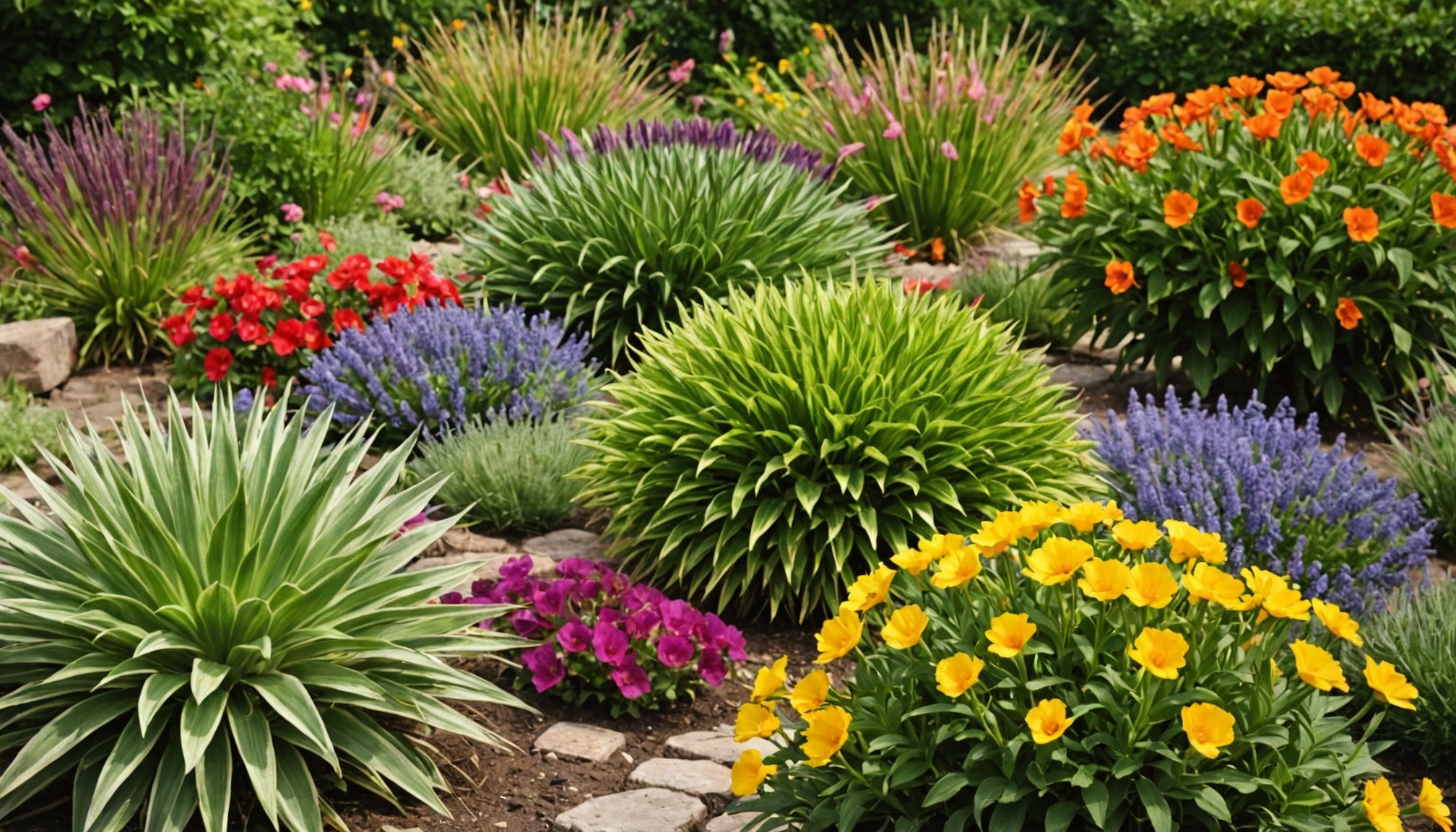Overview of Drought-Resilient Gardening
Securing a sustainable garden in the UK calls for the selection of drought-resistant plants. Climate change has intensified the need for drought resilience due to alternating weather patterns. These plants are not just vital for enduring dry conditions, but they also thrive in less frequent watering environments, saving time and resources.
Importance of Drought-Resilience in UK Gardens
The shift to drought-resilient gardening helps conserve water—a precious resource. Given fluctuating rain patterns and increasing water restrictions, gardens equipped to withstand drought reduce the strain on domestic water supplies. They empower gardeners to maintain vibrant landscapes even when water is scarce.
A lire aussi : Top Toddler-Friendly Stair Gate Solutions for Two-Story Homes in Birmingham: Ensuring Safety and Peace of Mind
Environmental Benefits and Water Conservation
Beyond personal advantages, adopting drought-resistant plants contributes to broader environmental goals. These plants typically require minimal intervention, reducing dependency on water, fertilisers, and pesticides. This practice promotes biodiversity and reduces the carbon footprint of routine garden maintenance. Through this approach, even modest gardens have the potential to make a meaningful ecological impact.
Plant Selection Under Drought Conditions
In the UK, where gardens often rely on traditional plant varieties, selecting the right species becomes crucial under drought conditions. Hardy plants such as lavender, ornamental grasses, or succulents are excellent choices. They are effective in maintaining the aesthetic and health of your garden without extensive water usage. Adjusting plant selection is one practical step towards a more resilient and eco-friendly garden.
A voir aussi : Ultimate Guide to Waterproofing Your Basement: Top Strategies for UK Homes
Top Drought-Resilient Plants for UK Gardens
Choosing the best drought-tolerant plants can transform your garden into a thriving oasis, even during dry spells typical of the UK climate.
Plant 1: Lavender
Lavender is celebrated for its fragrant blooms and silver-green foliage. Thriving in well-drained soil and full sunlight, this plant is quintessential for UK gardens. Minimal care is needed; pruning is recommended post-flowering to maintain shape. Lavender supports pollinators, enhancing biodiversity in your garden.
Plant 2: Echinacea
Echinacea, known for its vibrant petals and conical centre, prefers sunny spots with well-drained soil. Its deep root system makes it exceptionally drought-adaptable, handling sporadic watering with ease. Beyond aesthetics, Echinacea offers health benefits, often used in herbal remedies for boosting immune health.
Plant 3: Sedum
Sedum offers a variety of species, each with unique traits, such as “Autumn Joy” known for its rich pink blooms. This plant thrives in sunny locations and tolerates poor soil conditions, making it versatile for garden design. Sedum also supports ecological balance by providing habitat for insects, promoting a healthy garden ecosystem.
Implementation and Care Tips
Embarking on a drought-tolerant gardening journey necessitates thoughtful plant care strategies. At the core lies preparing the garden soil to support such resilient plants. Start by enhancing soil with organic matter. This enriches fertility and improves water retention, crucial for plants thriving in dry conditions.
Next, understand watering schedules and techniques adapted to the climate. Rather than frequent, shallow watering, opt for deep watering to encourage roots to delve deeper into the soil. This technique strengthens plants against infrequent watering periods, making them less reliant on constant moisture.
Mulching acts as a protective, moisture-conserving layer. It reduces evaporation and suppresses weeds that compete for water. Apply a thick layer of organic mulch around your plants to optimize these benefits.
Incorporate permanent features such as drip irrigation systems for efficient water use. This method targets roots, minimising wastage by preventing water from being lost to evaporation elsewhere.
Attention to garden maintenance ensures prolonged viability. Regularly check for signs of over or underwatering, adjusting methods accordingly. With these insights in your toolkit, transform garden care into a seamless routine, nurturing growth amidst the challenges of arid climates.
Seasonal Considerations for Planting
Understanding seasonal planting is crucial for gardeners, especially when aiming to cultivate thriving plants across varying climates. The gardening calendar offers insights into when different species should ideally be introduced to your garden, ensuring each has the best chance to flourish.
Best Seasons for Planting Drought-Resilient Species
For gardeners in the UK, timing is key, and the best seasons for planting drought-resilient species are typically spring and autumn. These seasons provide moderate temperatures and adequate rainfall, which assist in root establishment, crucial for long-term survival. Adjust seasonal care by considering factors such as temperature and moisture availability to ensure plants thrive despite potentially adverse conditions. Proper timing in the gardening calendar enhances plants’ resilience and adaptability.
Seasonal Maintenance Advice
As seasons shift, adapt your planting tips to ensure ongoing plant health. For example, adjusting watering schedules and fertilization can compensate for changing weather patterns. Keep a vigilant eye on plant health year-round, fine-tuning care routines to maintain vigor. As winter approaches, prepare for dormancy by reducing water and nutrients, letting the plant conserve energy. Spring invites a rebirth, encouraging nourishment and increased care to stimulate new growth. Seasonal adjustments ensure your garden flourishes, regardless of the time of year.
Landscaping Design with Drought-Resilient Plants
Incorporating drought-tolerant plants into your garden design is a smart way to conserve water while still achieving a visually stunning landscape. These landscaping ideas focus on using hardy plants that thrive in dry conditions, enabling you to create a beautiful and sustainable environment.
To begin, consider choosing plants like succulents, lavender, or rosemary, which are known for their ability to withstand dry spells. Integrating them into your existing garden design can be both simple and rewarding. Using these low-maintenance plants not only reduces water usage but also minimizes the time spent on upkeep, making them an excellent choice for busy homeowners.
Creating visual interest in a drought-resistant landscape involves a thoughtful approach to plant placement. Employing landscape design principles such as grouping plants with similar water, soil, and light needs together helps optimize their growth and enhance their natural beauty. These strategic groupings also promote efficient water use, ensuring each plant receives the right amount of moisture.
By focusing on these landscaping ideas, you can devise a garden that is not only aesthetically pleasing but also environmentally sensible. Embracing a drought-resistant landscape allows you to enjoy the beauty of nature without compromising on sustainability.
Environmental Benefits of Drought-Resistant Plants
Eco-friendly gardening is not only about aesthetic appeal but also about embracing a sustainable approach that benefits the ecosystem. Drought-tolerant gardens play a significant role in promoting biodiversity by offering a habitat for local wildlife. These gardens provide nectar and shelter for pollinators such as bees and butterflies, which are crucial for maintaining ecological balance.
Moreover, these plants contribute to urban greening efforts, which are vital for improving air quality in densely populated areas. By reducing soil erosion and stabilizing temperatures, drought-resistant plants create cooler environments, which can decrease the urban heat island effect, thereby improving overall livability.
In terms of climate resilience, these gardens help buffer against environmental changes and weather extremes. They require less water, which conserves precious resources, making them a practical choice in regions prone to water scarcity. By sequestering carbon and reducing greenhouse gase emissions, these plants play a crucial part in combating climate change.
Choosing drought-resistant plants not only supports environmental conservation but also promotes long-term sustainability. Their ability to thrive in challenging conditions serves as a model for adapting to climate unpredictability, illustrating how mindful gardening practices can positively impact the environment for future generations.











